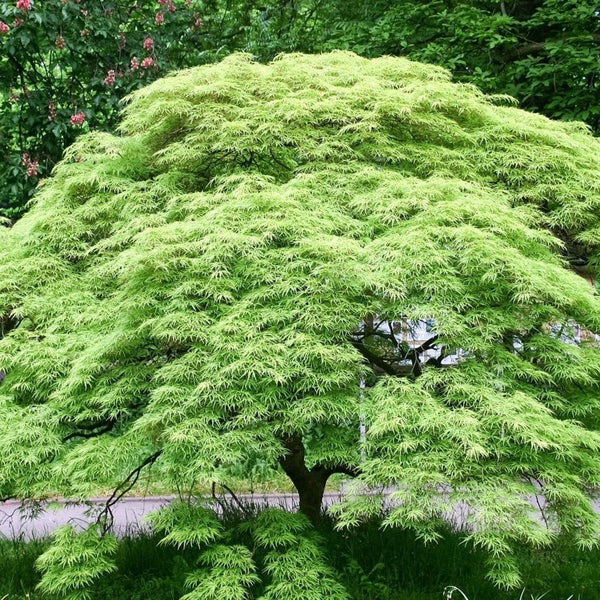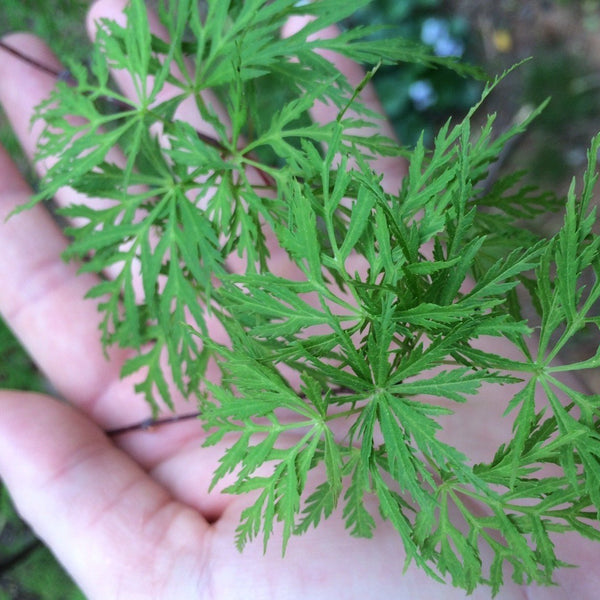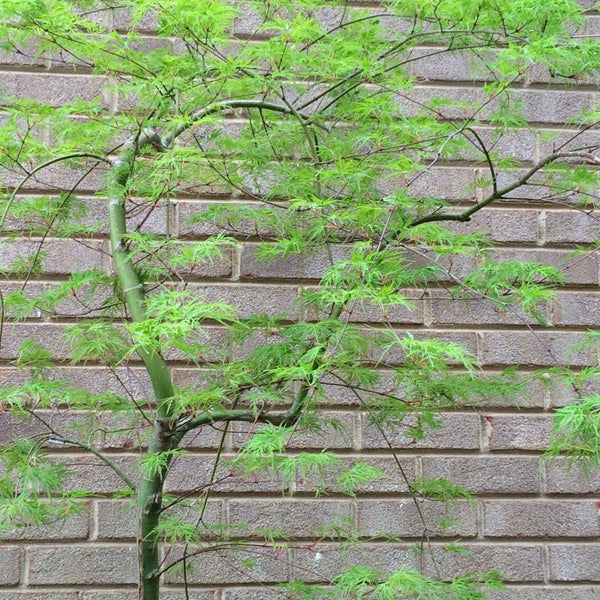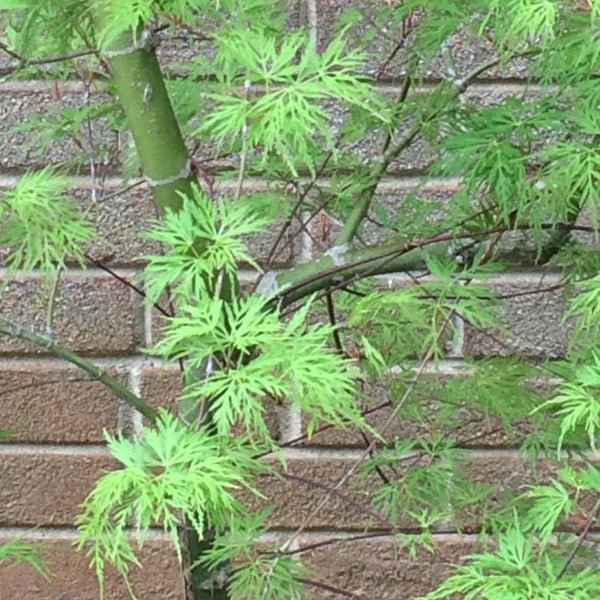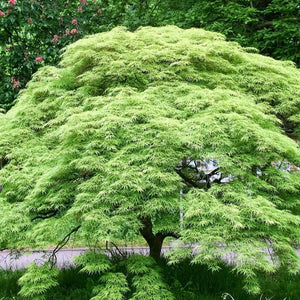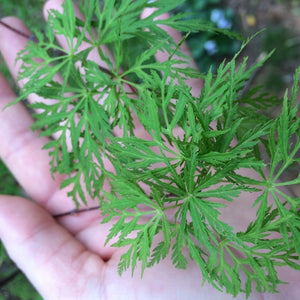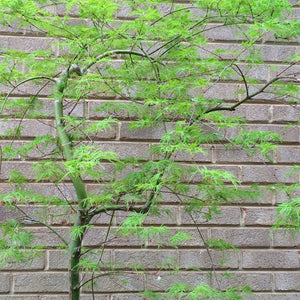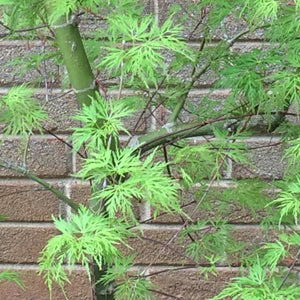Weeping Viridis Japanese Maple
Product Details
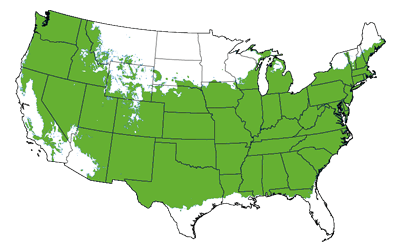 Growing Zones 5-8
Growing Zones 5-8
| Soil Type | Acidic, Adaptable, Well Drained |
| Sunlight | Full, Partial |
| Drought Tolerance | Semi |
| Mature Height | 6-10 Feet |
| Mature Width | 6-10 Feet |
| Growth Rate | slow |
| Fall Color | Yellow |
| Bloom Color | Red |
| Shipping Restriction | AZ |
You are going to love adding this Green Weeping Japanese Maple to your collection. The Weeping Maple is the perfect tree for highlighting a red-leafed variety. But this tree also stands alone as a perfect focal for a rock garden...and so much more! You will absolutely love the peaceful beauty the Viridis Japanese Maple brings to your yard!
The delicate, lacy leaves are a lovely, light green in spring and summer. This color really makes this tree stand out, looking beautiful even in a simple yard with grass, as the greens contrast each other. You won't believe the gorgeous fall color...a golden yellow with hints of orange and red.
This compact Weeping Japanese Maple can tolerate full sun in cooler climates. However, in southern regions be sure that your tree receives afternoon shade to avoid sun scorch. Keeping your soil moist, but not wet will also help protect your Japanese Maple from summer heat and sun. With proper watering this variety rarely has issues with pests or diseases. Plan for a mature height of 6 to 8 feet and spread of 8 to 12. This variety is great for containers and tends to stay a bit smaller in a container.
Feel the OMMMM sitting next your very own Weeping Japanese Maple. Order yours today!
How Far Should I Space A Weeping Japanese Maple?
Plan to space these trees 6 feet apart to accomodate a amture spread of 6-8 feet.
How Do I Winterize This Maple?
Be sure to water your tree heavily and not fertilize into late summer. Lay down a 3-4 inch thick layer of mulch before the frost to protect the root system and maintain moisture.
When Is The Best Time To Prune This Tree?
Prune when they are dormant to remove any dead, dying, or crowded branches, or to maintain shape.
When planting your Weeping Japanese Maple be sure you have the right location and conditions for your new tree to thrive. Spring and Fall are ideal times to plant. However, if you avoid freezing and hot temperatures you can plant your Maple almost any time of the year.
Lace Leaf Japanese Maples tolerate full sun to part shade. Choose part sun/shade unless you are in a cooler growing zone, like a 5 or 6. In sunny spots you may see some leaf scorch when these trees are young, especially if they are not getting adequate water. Keep your tree watered if you do notice leaf scorch, but don't panic. Leaf Scorch is not going to affect the overall health of your tree. Japanese Maples prefer soil that is well-drained, but moist, neutral to slightly acidic, and nutrient rich. However, Japanese Maples will adapt to a variety of soils. Mulching will keep the roots moist and protect them from extreme temperatures in winter. Add a layer of 2 to 3 inches of mulch. Do not allow the mulch to touch the trunk as this increases the chances of pests and disease. Japanese Maples should be watered often enough to keep the soil moist. Do not allow the the soil to dry completely or be overly saturated. Either condition can harm a Japanese Maple. Fertilize in early spring and when planting to give your tree a boost. Choose a slow release fertilizer. When planting take care not to burn the roots by mixing the fertilizer into the soil before placing your tree in the hole. Lace Leaf Maples don't generally require pruning, but, if needed, prune when they are dormant to remove any dead, dying, or crowded branches, or to maintain shape.
The best way to prevent disease and pests is by providing the appropriate care for your plants. Proper location choice, watering, and fertilization are the keys to your success. Scale, Mites, and Aphid are insects that can occasionally affect Japanese Maples. You can treat these pests naturally with horticultural oil, neem oil, or insecticidal soap. For severe infections you can use pesticides like carbaryl, also known as Sevin. Another potential pest of the Japanese Maples is the Japanese Beetle. Look into parasitic nematodes and bacillus thuringiensis for effective, organic control of this pest.



